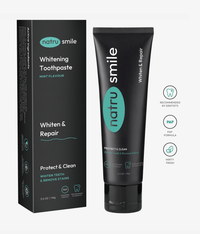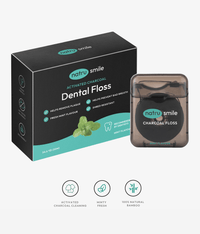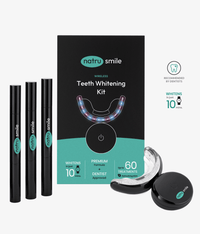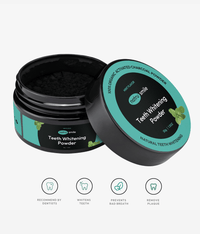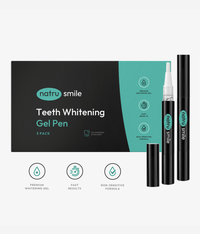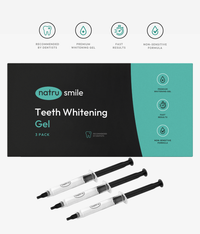
All products are certified by dental expert Dr. Greg Grillo
Applying dental filling is one of the most common treatments used by dentists to restore teeth. A temporary filling is then used as a short-term solution for teeth that need immediate attention but do not require permanent restoration yet. This filling is temporary, so it's not meant to last.
That being said, what exactly is a temporary tooth filling, why is it applied, and how is it maintained? You will find in-depth information and more about temporary dental fillings in this article.
What’s A Temporary Dental Filling? A Quick Look
Temporary dental fillings are a common procedure used to treat minor tooth decay. A temporary filling does not need to be as hard-wearing as a permanent one since it will only stay in place until replaced.
Fillings are typically composed of different types of materials, such as composite resins, porcelain, or amalgam. In most cases, glass ionomer is the most common material used because of its strength while still being soft enough to last for several weeks or months.
Temporary fillings for teeth can be easily removed by the dentist when they are replaced with a more permanent restoration such as a crown or filling. These may also have a tooth-like coloration but usually have some tint so that the dentist can identify them quickly when replacing them.
These can also provide relief from pain and discomfort while protecting the affected area until you’re ready for a permanent restoration. It’s essential to keep up with regular dental checkups and cleanings so that any issues can be addressed quickly before they become more serious.
Who Needs A Temporary Tooth Filling
If you are experiencing tooth pain, a temporary filling may be just what you need. Dentists can apply temporary fillings in cases where time is an issue. This is also an inexpensive and easy way to relieve the symptoms of a dental issue until treatment can be completed.
These are the common reasons you might need a temporary filling.
Tooth Decay
Tooth decay is the most common issue that can lead to the need for temporary tooth fillings. Tooth decay occurs when bacteria in the mouth break down carbohydrates, like sugar, and produce acids that attack the enamel of teeth.
This condition causes cavities that weaken the structure of teeth and create openings in them where food particles can become stuck. This leads to further bacterial growth and an increased risk of infection.
The purpose of temporary dental fillings is to prevent further damage to these weakened teeth until more permanent repairs can be made and still allow proper oral hygiene to be maintained.
Acid Erosion
Acid erosion refers to a form of tooth decay that is caused by acid attacking the enamel on your teeth. After the enamel has been eroded away by acid, the dentin layer beneath is exposed, which is more susceptible to decay.
Many factors can contribute to this condition, including drinking acidic beverages such as sodas, sports drinks, and energy drinks, eating acidic foods such as citrus fruits or tomatoes, regurgitating stomach acid due to GERD (gastroesophageal reflux disease), using toothpaste with low levels of fluoride, and even some medical conditions like anorexia nervosa.
If you're wondering if teeth whitening kits, because of their bleaching properties, can cause damage to enamel and dentin, the answer is no. If you follow your dentist's instructions and follow the product label instructions, your teeth whitening toothpaste is safe to use.
The good news is that acid erosion can be treated with temporary fillings. The type of filling that your dentist chooses will depend on the extent of the damage to your teeth, as well as any other dental work that you may need.
Physical Trauma
A temporary tooth filling is an effective dental procedure that can help to restore the appearance and function of a damaged tooth. While it is often used for minor cavities, a temporary filling may be necessary in some cases when physical trauma has caused significant damage to a tooth or teeth.
Physical trauma due to sports injuries or accidents is a common cause of broken and chipped teeth, as well as other forms of oral injury. When this kind of physical trauma happens, prompt medical attention is crucial so that any underlying injuries can be addressed and the teeth can be evaluated.
Depending on the extent of the trauma, a dentist may recommend temporary filling as part of treatment. This is meant to protect any exposed parts of a damaged tooth from further injury or infection until more permanent repairs can be made.
How Long Does A Temporary Filling Last?
Although the exact time frame is not specified, a successful temporary filling should remain in place for a period ranging from a few weeks up to two months. Over time, it will become friable and fall out naturally.
It is essential to follow aftercare instructions in order for your dental filling material to stay intact and without any issues. Your dentist will place the temporary filling and caution you not to put too much pressure on it.
No matter why you need a temporary filling, you should always have clear instructions on what steps to take next. The dentist usually wants to schedule an appointment soon so they can remove or change the existing one. Crowns and root canals should be performed as soon as possible if necessary.
What Is The Procedure For Putting In A Temporary Filling?
The procedure for putting in a temporary filling typically involves numbing the area around the affected tooth, cleaning out any debris from within the cavity, and then packing the cavity with an appropriate material. This material may vary depending on how long it needs to last and whether or not extra protection is needed against further decay.
After this step has been completed, dentists usually apply a layer of cement over the packed material before finally placing some sort of protective coating or sealant on top to help keep the material in place. The process of treatment is quite simple, and most people can be finished in under 40 minutes.
Caring For A Temporary Filling
A temporary filling is a short-term fix used to fill in small cavities, cracks, and chips while you wait for your permanent filling to be placed. Taking care of it properly will help ensure that it lasts until your follow-up appointment with the dentist.
Here are some tips on how to take care of your temporary filling:
- Avoid chewing hard foods - Although a temporary filling can provide relief from sensitivity, you should still avoid chewing hard and sticky foods as they may dislodge or break the filling. Instead, stick to soft foods like yogurt, mashed potatoes, and soups which will be much gentler on the filling.
- Avoid biting down too hard - Just as with hard foods, it is important to be gentle when biting down with your temporary filling in place. Although it may seem like normal pressure, biting down too hard can cause the filling to come out and create further damage to your tooth.
- Keep it clean - Proper oral hygiene will help keep your temporary filling clean and free from bacteria that can cause decay or infection in the area around the filling. Brush twice a day and floss once a day for best results, paying special attention to areas near the fillings, so bacteria does not spread.
- Avoid hot and cold drinks - Drinks that are too hot or too cold can cause discomfort when the filling is in place, as the material may expand or contract due to temperature changes. To avoid this, stick to lukewarm beverages until your appointment with the dentist for a permanent filling.
By following these simple tips, you will be able to take good care of your temporary fillings and ensure that they last until your next appointment.
Side Effects Of Having A Temporary Filling
While temporary fillings are beneficial, there are some potential side effects associated with having one placed. When it comes down to it, its placement is just a short-term fix for the underlying cause.
They Don’t Remove The Decay
Unfortunately, due to its soft nature, a temporary filling is not able to completely eliminate decayed areas of the tooth. Having temporary fillings isn't necessarily about removing the decay but rather about protecting the area until a permanent restoration can be completed.
DIY Fillings Fall Out
The moment a filling falls out, the hole becomes open to bacteria. Even with careful brushing and flossing, little particles of food can still be trapped inside. Temporary fillings also don't always have enough strength to withstand normal biting forces, which means that they won’t be able to provide protection for long periods of time.
It should also be noted that with the #DIYDentist trend sweeping the internet with at-home kits and "hacks," this can be dangerous for those with serious dental issues. So, it's always advisable to see a dentist.
They Don't Color Match
Temporary fillings do not color match as a side effect because they are just that - temporary. It is not necessary for temporary fillings to color match since they will eventually be taken out and replaced with something more permanent.
Additionally, since the material used for temporary fillings does not last as long as other materials like composite resin or ceramics, it can often discolor over time due to exposure to bacteria or other factors in the mouth.
Discomfort And Pain When Eating
It is common to experience tooth pain after a filling because the material is rigid. Temporary fillings are usually made of materials that harden quickly, so they lack the flexibility of permanent filling materials.
These rigid materials can press against the nerve endings inside your tooth when you bite down on them, leading to discomfort and even pain while eating. The discomfort and pain you experience with a temporary filling often subside once the permanent solution is in place.
Here are some key points of information related to temporary filling to keep you informed.
Will A Temporary Filling Stop The Pain?
A temporary filling is placed to soothe the nerve and allow the tooth to heal until a permanent one is put in. Most temporary fillings include numbing agents that begin working right away.
Nonetheless, it's essential to get the cavity filled even if you don't have any discomfort. If there's severe sensitivity or soreness when dealing with an exposed nerve or during a procedure, a sedative filling may be applied as an alternative.
Can You Smoke After A Root Canal With A Temporary Filling?
Smoking should be avoided during the initial period after a root canal, along with avoiding eating or drinking hot beverages since your mouth will still be numb. Overstimulating your mouth during recovery can slow down the healing process.
Even if you have smoked for many years, quitting will improve your oral health and reduce the likelihood of gum disease. Smoking also weakens the immune system, making it more difficult for the body to fight infections.
How To Remove Store-Bought Temporary Fillings?
If the filling has been set and hardened, it cannot be removed without a visit to the dentist. If it is still soft, you can try to remove it with a toothpick or cotton swab but ensure not to damage your tooth or gum tissue. Keep in mind that temporary fillings are only meant as a short-term solution, so if you're having discomfort, contact your dentist promptly for a permanent replacement.
Can I Eat After A Temporary Filling?
Your dentist will explain what to do after your appointment, but usually, it's advisable to wait until the numbness from the anesthesia has worn away before eating. This is so you don't accidentally bite your tongue or cheeks.
For some fillings, you may need to wait a full day before consuming food on the side of your mouth with the filling installed in order for it to stay put.
Can You Brush Your Teeth With A Temporary Filling?
After receiving a temporary filling, you may be uncertain about how to brush the filled tooth. You do not need to worry, however, as you can brush it just like your other teeth. Flossing around it may be difficult, so proceed with caution if you choose to do so.
It's highly recommended to use a soft bristle toothbrush and gently clean the surface of the new filling.
Do Dentists Recommend Temporary Fillings?
A temporary filling is an effective way to guard a damaged tooth in the time leading up to a permanent procedure. Dentists suggest this option, but it should not be seen as a long-term solution. A temporary tooth filling kit at home does not necessarily harm your teeth, but it would be ineffective, so it is best to have a professional perform the procedure.
Make sure you arrange an appointment with your dentist soon so you can replace the temporary filling with a permanent one. Doing this will help keep your tooth from deteriorating and becoming infected any further.
What Can You Not Eat With A Temporary Filling?
Temporary fillings are able to withstand light chewing. As these are temporary-placed, it is advised to steer clear of hard or sticky foods like candy, nuts, and gum while they last. It is true that you can eat everything in moderation, but there are some foods that are particularly harmful to your teeth and are most likely to cause complications.
Why Do Dentists Use Temporary Fillings?
Your dentist may place a temporary filling with medication if your tooth is causing you discomfort. This will help reduce sensitivity and allow the tooth to heal before adding permanent treatment. Although there is no specific duration for a temporary filling, the right temporary fillings for teeth should last up to a few months.
What Happens If A Temporary Filling Falls Out?
If you have lost a temporary dental filling, don't be alarmed. Contact your dentist and make an appointment to restore it. However, if there is bleeding that won't cease or swelling that is worsening, immediate medical attention is necessary.
What Foods Can You Eat With A Temporary Filling?
Avoid eating sticky, chewy, or hard foods until the cement has time to set properly if a temporary filling has been placed. Eating a soft-food diet is generally recommended until the permanent filling has been placed so that you can avoid any potential damage or discomfort from consuming harder foods.
Some good food options for when you have a temporary filling include soft fruits and vegetables such as bananas, applesauce, cooked carrots, and mashed potatoes; protein-rich sources like eggs, chicken, and fish; and dairy products like yogurt and cheese. Soft starches such as pasta, rice, oatmeal, and quinoa can also be used as dietary fiber.
Do You Need Anesthesia For A Temporary Filling?
The process of getting a temporary filling is much like that of a regular cavity filling. The dentist will use novocaine or another local anesthetic to numb the tooth and gums nearby. This procedure is quite fast and painless, usually taking up to 40 minutes to complete. A local anesthetic may be administered by your dentist so that you will not feel any discomfort during the procedure.
Can I Buy A Temporary Tooth Filling?
A DIY temporary tooth filling kit can provide relief if you cannot get to a dentist immediately. These kits are suitable for repairing lost fillings or crowns, chipped teeth, and broken teeth. With the help of these kits, you can quickly fix your tooth and ease any discomfort you may be feeling.
It is, however, recommended to schedule an appointment with a professional to have the filling checked and to determine the underlying cause.
In Conclusion
Getting a temporary filling is an effective way to bridge the gap between having an extraction and getting a permanent restoration. It provides a safe, secure, and affordable solution for those who need immediate relief from their toothache or discomfort caused by dental caries.
With proper care instructions given by your dentist, you can ensure that your temporary filling stays intact until you are ready for your permanent restoration.


